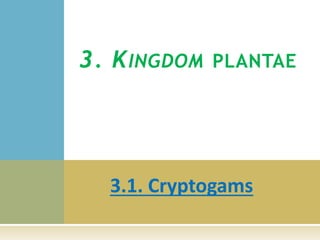
Kingdom plantae
- 1. 3.1. Cryptogams 3. KINGDOM PLANTAE
- 3. Kingdom Plantae is further classified on the basis of characteristics like absence or presence of seeds, vascular tissues, differentiation of plant body, etc. Phanerogams Cryptogams are commonly called seed producing plants. are spore producing plants and do not produce seeds and flowers. They produce special reproductive structures that are visible (Phaneros – visible) They reproduce sexually by gametes but sex organs are concealed (kryptos : hidden, gamos : marriage).
- 4. SALIENT FEATURES OF PLANT GROUPS UNDER CRYPTOGAMS
- 5. 1. THALLOPHYTA Members are mostly aquatic, few grow on other plants as epiphytes. Some grow symbiotically and epizoic i.e. growing or living non-parasitically on the exterior of living organisms. Plant body is thalloid i.e. undifferentiated into root, stem and leaves. They may be small, unicellular, microscopic like Chlorella (nonmotile), Chlamydomonas (motile). They can be multicellular, unbranched, filamentous like Spirogyra or branched, filamentous like Chara.
- 6. •The algal cell wall contains either polysacchrides like cellulose / glucose or a verity of proteins or both. •Reproduction takes place by vegetative asexual and sexual way. •The life cycle shows phenomenon of alternation of generation, dominant haploid and reduced diploid phases. Algae Chlorophyceae (green algae) Phaeophyceae (Brown algae) Rhodophyceae (Red algae)
- 7. A. CHLOROPHYCEAE (GREEN ALGAE) Plant body is unicellular, colonial, filamentous. Cell wall contains cellulose. Chloroplasts are of various shapes like discoid, plate-like, reticulate, cup-shaped, ribbon-shaped or spiral with chlorophyll a and Members are rich in protein, so used as food e.g. Chlorella. Chlamydomonas, Spirogyra, Chara, Volvox, Ulothrix etc.
- 8. B.PHAEOPHYCEAE (BROWN ALGAE) Plant body : Mostly marine, rarely fresh water. Simple branched / filamentous (e.g.Ectocarpus) / profusely branched (Petalonia). leaf-like photosynthetic organ called frond. Many species of marine algae are used as food. e.g. Laminaria, Sargassum. Some species are used for production of hydrocolloids. e.g. Ectocarpus, Fucus, etc.
- 9. C. RHODOPHYCEAE (RED ALGAE) These are found in marine as well as fresh water on the surface, deep sea and brakish water. Cell wall is made up of cellulose and pectin glued with other carbohydrates. Stored food is in the form of Floridean starch. e.g. Chondrus, Batrachospermum Porphyra, Gelidium , Gracillaria, Polysiphonia,
- 10. 2. BRYOPHYTA (BRYON : MOSS ; PHYTON : PLANT) Bryophytes are mostly terrestrial plants. They are found in moist shady places. But they need water for fertilization and completion of their life cycle. Hence they are called ‘amphibious plants’. They include approximately 960 genera and about 25,000 species. Life cycle of Bryophytes shows sporophytic and gametophytic stages.. Bryophytes have root-like structures called rhizoids. Rhizoids are unicellular in liverworts while multicellular in mosses.
- 11. Bryophytes are divided into two groups : liverworts and mosses. Bryophytes Mosses Liverworts
- 12. A. LIVERWORTS (HEPATICEAE) : •These are lower members of Bryophyta. Gametophyte possesses flat plant body called thallus. The thallus is green, dorsiventral, prostrate with unicellular rhizoids. e.g. Riccia, Marchantia. •Hornworts (Anthocerotae) - These member possess flattened thallus. The thallus produces horny structures which are called sporophytes hence the name hornworts. e.g. Anthoceros.
- 13. B. MOSSES (MUSCI) •These are advanced members of Bryophyta which possess erect plant body. Gametophytic phase of the life cycle includes two stages namely; protonema stage and leafy stage. •Protonema helps in the vegetative propagation. •The leafy stage has erect, slender stem like (Cauloid) main axis bearing spiral leaf like structures (Phylloid). •This stage bears sex organs. Vegetative reproduction takes place by fragmentation e.g. Funaria, Polytrichum, Sphagnum, etc.
- 14. 3. PTERIDOPHYTA Nephrolepis (Fern) •These plants have a primitive conducting system and they are the only Cryptogams with vascular tissues. The late Paleozoic era is regarded as the age of Pteridophytes. •The group has about 400 genera and 11,000 species. (e.g. Selaginella) or large called macrophylls (e.g. Nephrolepis )
- 15. •Pteridophytes grow in moist and shady places. Pteridophytes show sporophytic and gametophytic stages in life cycle. e.g. Ferns, Horsetail. •Pteriodphytes show heteromorphic alternation of generations in which the sporophyte is diploid, dominant, autotrophic and independent. •It is differentiated into root, stem and leaves. •In these members Xylem consists of only tracheids and Phloem consists of only sieve cells. Secondary growth is not seen in Pteridophytes due to absence of cambium.
- 16. Pteridophytes are classified as - 1. Psilopsida- (Psilotum) 2. Lycopsida - (Selaginella and Lycopodium), 3. Sphenopsida - (Equiesetum) 4. Pteropsida - (Dryopteris, Pteris and Adiantum) Economic importance - Pteridophytes are Used for medicinal purpose and as soil binders. Many varieties are grown as ornamental plants.